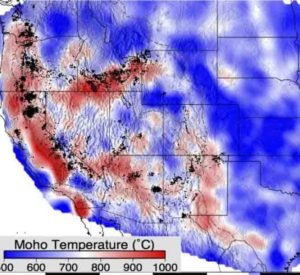
Everything on the surface of the Earth rests on massive tectonic plates that resemble a jelly sandwich, with two rigid pieces — the upper crust and the upper mantle — enclosing a gooey middle layer of very hot rocks, which is the lower crust. The plates move ever so slowly around the globe over a deeper hot layer called the asthenosphere.
Temperature plays a fundamental role in determining the strength, thickness, and buoyancy of the lower crust. A research team led by Colorado State University has mapped the temperature and viscosity of the lower crust for the first time and found that, under much of the western United States, the layer is hot enough to be near its initial melting point and, therefore, quite runny.
This new research shows that significant regions of the lower crust have little strength, and that over several million years, could lead to many mountains in the western U.S. being flattened.
“Having a map of the temperature gives us an understanding of how strong the plate is,” said Derek Schutt, associate professor in CSU’s Department of Geosciences. “What we found is that there are places where the crust is not strong enough to hold the topography.”
Imagine three slices of Silly Putty, two frozen pieces lying on the top and bottom of one that is room temperature. When you push on the top layer, the warm Silly Putty will be squeezed flat. Similar mechanics are at work in the Earth’s crust.
“Mountains are formed by forces pushing things around, and weak areas collapsing,” according to Schutt.
Outside forces could potentially push on the crust and that force could be transferred deep inland, which is called orogenic float, he said. The new study suggests this process may occur more often than previously thought.
“That can cause mountains to form at a great distance from where you’re pushing on things,” Schutt said. “Because the lower crust is mobile, force can be transmitted over a large distance.”
Scientists generally think of tectonic plates, or lithosphere, as being made up of the crust and a cold uppermost mantle. But in this new analysis, the team saw something akin to ball bearings slipping between the crust and mantle. While not unexpected, this study was able to map the extent of the areas resembling ball bearings.
“The ‘ball bearings’ keep separate what’s happening in the mantle from what’s happening in the crust,” said Schutt.
Researchers calculated temperatures at the bottom of the crust, which varies in thickness, by measuring the velocity of seismic waves that travel near the interface between the lower crust and uppermost mantle.
In the western U.S., the crust is very hot, which is what makes it so weak.
“We know in general that the lower crust in the western United States seems hot,” said Schutt. “But this is the first time we’ve been able to really ascribe a temperature to a specific location.”
The findings, he said, are not too surprising. But the research could lead to more insight about why mountains exist and, more specifically, why they exist in places where the temperatures in the lower crust are so high.
Schutt and the research team will continue to explore the causes of variations in tectonic plate strength as part of an ongoing project between Colorado State University, Utah State University, and Scripps Institution of Oceanography at the University of California, San Diego. This research is funded by the National Science Foundation’s Earthscope Program.
Reference:
Derek L. Schutt, Anthony R. Lowry, Janine S. Buehler. Moho temperature and mobility of lower crust in the western United States. Geology, 2018; DOI: 10.1130/G39507.1
Note: The above post is reprinted from materials provided by Colorado State University.










